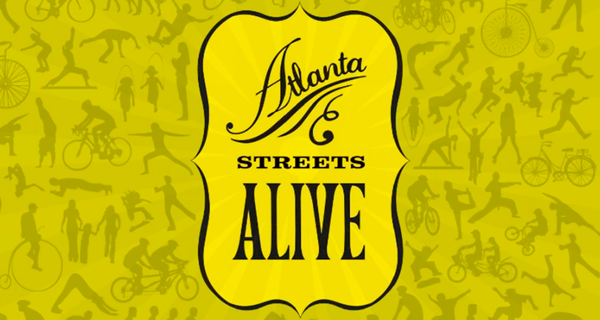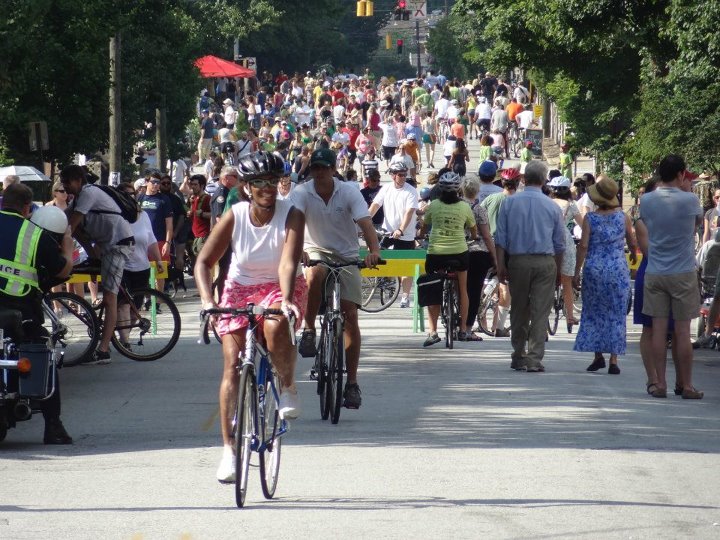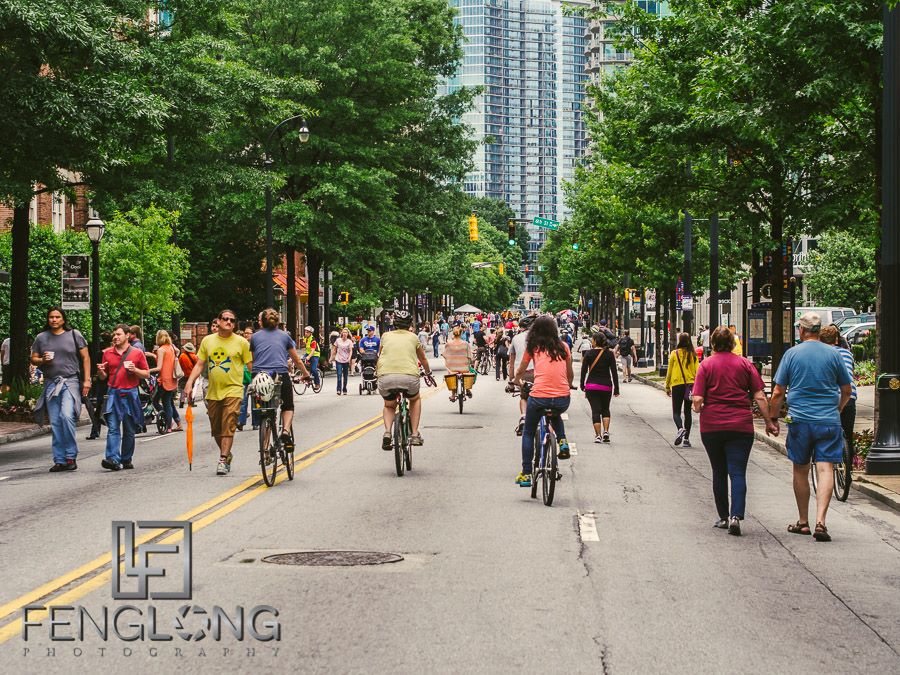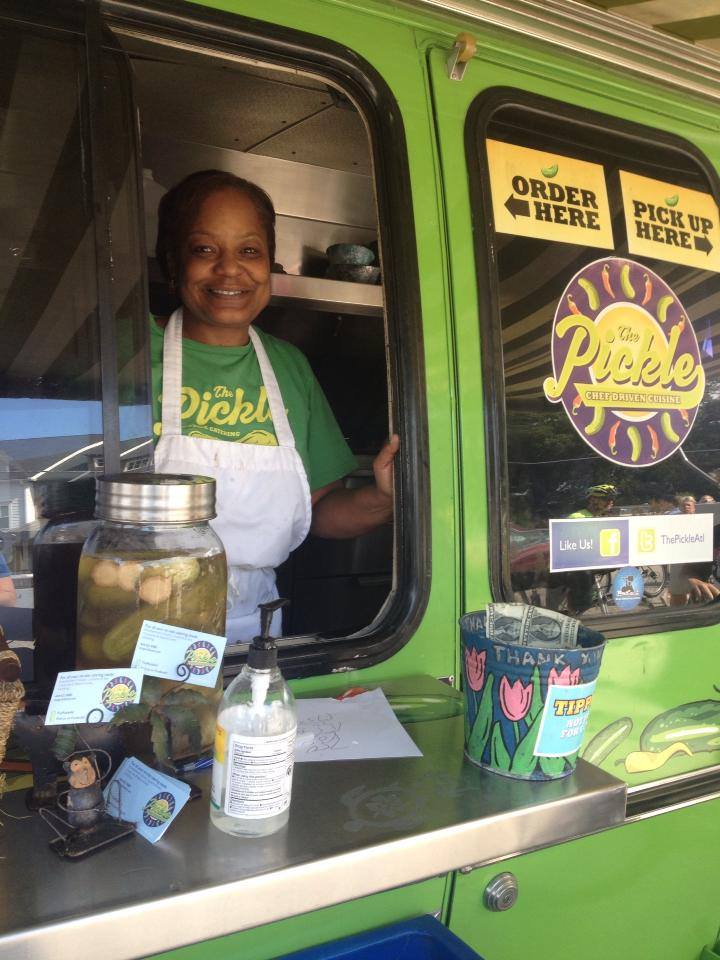 For Rebecca Serna the power of Open Streets wasn’t an exciting concept she read about in a book or a vibrant event she saw in a Streetfilms video.
For Rebecca Serna the power of Open Streets wasn’t an exciting concept she read about in a book or a vibrant event she saw in a Streetfilms video.
She felt it firsthand.
When the Executive Director of the Atlanta Bicycle Coalition studied participatory planning and budgeting she traveled abroad to Colombia — the birthplace of ciclovia — for a year.
“And I lived on the ciclovia route, so I saw it every Sunday,” she says. “I was impressed by how much of the city it drew in. It wasn’t a niche event; by that point, it was part of the city’s culture.”
Thanks in large part to the leadership of Serna and the ABC that culture is now shifting residents’ perspectives on active transportation in Atlanta, too. And we’re delighted that the home of Atlanta Streets Alive — which now draws more than 100,000 residents to its events — will host the 2015 National Open Streets Summit, presented by the Open Streets Project this September.
So how did ciclovia gain traction in car-centric southern metropolis that boasts 5.5 million residents? And how has that impacted bicycle and pedestrian advocacy in our nation’s 9th largest city? I spoke with Serna last month to learn more.
Here are three reasons you don’t want to miss the opportunity to participate in and learn from Atlanta Streets Alive.
1. From 5,000 to 100,000 participants in five short years
 When Serna got back from Colombia and started with the Atlanta Bicycle Coalition, progress was… slow. Riding her bike most places, the ABC ED became accustomed to people being shocked at her arrival on a bike, noting their support for the concept but a complete inability to picture themselves doing the same in the “dangerous” Atlanta traffic. Clearly, to advance biking in the region, they needed to find a way to show residents a different reality.
When Serna got back from Colombia and started with the Atlanta Bicycle Coalition, progress was… slow. Riding her bike most places, the ABC ED became accustomed to people being shocked at her arrival on a bike, noting their support for the concept but a complete inability to picture themselves doing the same in the “dangerous” Atlanta traffic. Clearly, to advance biking in the region, they needed to find a way to show residents a different reality.
“I felt like an Open Streets event was an idea so far outside of everything we were talking or thinking about,” Serna says. “Opening up streets and taking cars out of the equation would help people experience how great it is to escape your car. I knew we’d never get a large number of people to get that unless we took cars out of the picture.”
So, in 2010, the ABC got to work planning what would become Atlanta Streets Alive. And they quickly found some powerful allies.
“Some people got it immediately,” Serna says. “Some were so inspired, and really motivated to help that we formed a planning committee. We met at the MPO [Metropolitan Planning Organization] and I invited Kwanza Hall, a councilperson for that district to come to the first meeting. We didn’t have a close relationship at that point and I thought maybe he’d send a staff person — but he showed up too.
"He ended up being a really key figure in getting it off the ground," Serna adds. "He not only supported funding during the first year, but attended a ciclovia workshop in Guadalajara, Mexico, to experience it. He came back from that workshop and made a comment about the democratic space that is a democratic street — everyone out there mixing and mingling. His district is one of the most diverse in the city, so it was a big deal to him. He actually got off the plane and went and got a bike. When he tweeted picture with the bike and tagged us, I was literally jumping up and down in my office. [laugh]“
From the start, the organizers dreamed big, but were willing to make adjustments to meet the reality of city permitting and police costs.
 “My approach was ‘What would be the greatest thing ever — and let’s try to do that,’” Serna says. “Of course, that failed [laugh]. I wanted the first event to be on Peachtree Street, which goes through downtown and the city would not permit that street closure; it would have too big of a traffic impact even on a Sunday afternoon. So we had to take a step back and find a new route. That second proposed route was five miles long and still pretty ambitious. We got the cost on what we’d have to pay for the police to have that street closure and it was way beyond our means. So we had to scale way back to one mile on Edgewood downtown. We were hoping for 3,000 and I think 5,500 came, so we were pleased with that. We didn’t have any money for advertising, so it was all social media, the website and word of mouth.”
“My approach was ‘What would be the greatest thing ever — and let’s try to do that,’” Serna says. “Of course, that failed [laugh]. I wanted the first event to be on Peachtree Street, which goes through downtown and the city would not permit that street closure; it would have too big of a traffic impact even on a Sunday afternoon. So we had to take a step back and find a new route. That second proposed route was five miles long and still pretty ambitious. We got the cost on what we’d have to pay for the police to have that street closure and it was way beyond our means. So we had to scale way back to one mile on Edgewood downtown. We were hoping for 3,000 and I think 5,500 came, so we were pleased with that. We didn’t have any money for advertising, so it was all social media, the website and word of mouth.”
Fast forward five years later and that attendance has multiplied 20 fold, with four events scheduled for 2015.
“The growth in numbers has been tremendous,” Serna says. “The biggest event this past fall on about a five-mile route in Highland we estimated at about 106,000. So the margin of error was pretty much what we had at the first event. Some of the routes are more diverse than others, but I’d say it’s one of the most diverse events you see in Atlanta. There are so many neighborhood festivals but our neighborhoods are fairly segregated. We love that in the West End event, which is in a historically black community, the concept has gotten such a stronghold within the community.”
2. Changing the conversation about transportation

The power of Streets Alive, as Serna had hoped, transcends the boundaries of the events themselves, reframing the conversations about biking and walking in Atlanta.
“It’s hard to ever narrow down the success or change to one single factor, but I think Streets Alive is a big part of the change in Atlanta over the past five years,” Serna says. “You get a completely difference experience of the streets. It changes what people see as the future of that street.”
For example, imagine you live on North Highland Avenue, Serna poses. Everyday you grab a cup of joe at a local coffee shop. During Streets Alive, without the car traffic that makes the street a high-crash corridor, you decide to ride your bike there and realize, “Wow, that’s not that far away.” And then you get to thinking, “Man, if only there was a bike lane to make this safer on a daily basis…”
“We’re not to the point yet that Highland has a bike lane, but there’s a big passionate discussion about it and a lot of people are pushing for bike lanes saying, this is the kind of infrastructure that would support local business, even though it could take a whole lane of on-street parking,” Serna says. “That spirited discussion was not happening 10 years ago. It was never a consideration before.”
That’s the power of not just telling — but allowing tens of thousands of people to experience a different vision of what’s possible
“If we have 106,000 people show up and, according to our counts, about 60% of those folks are on bikes that’s 50-60,000 people on bikes in Atlanta at the same time,” Serna says.
And that, quite simply, can change everything.
3. Building coalitions and partnerships
 Atlanta Streets Alive hasn’t just awakened new participation from residents but seeded the growth of new and wide-reaching partnerships between the ABC, the city and community organizations. To name just a few…
Atlanta Streets Alive hasn’t just awakened new participation from residents but seeded the growth of new and wide-reaching partnerships between the ABC, the city and community organizations. To name just a few…
- PEDS, the local pedestrian advocacy organization, gave ABC an award for the most pedestrian friendly event a year ago and creates pop-up crosswalks during the events.
- The School of Public Health at Georgia State University has been conducting analysis of participant counts and observation and a participant survey.
- “The Atlanta Regional Commission has been a big player,” Serna says. “They’re actually a sponsor of this fall’s event and they’re going to be promoting the new bike share.”
- “And as the Area Resource on Aging, they've been really interested in tactical urbanism that brings out older adults,” Serna adds. “At the last one there was a pop-up bus shelter that was also a swing.”
- “The political partnerships are great, too,” she continues. “Councilmembers don’t see the event as just about bikes, so it’s easier to promote and be part of it. It feels very “come one, come all.”
With 50-60 activities planned during each event, Atlanta Streets Alive is one of the more “heavily programmed” events in the country, Serna explains. And that opens the doors to a wealth of partnerships, not only with city-wide organizations, but local businesses and neighborhoods.
“I actually think one of the most important partnerships is with the established neighborhood groups and leaders, who see it as a boon to their neighborhoods,” Serna says. “We don’t bring in any outside vendors — we want to develop good business relationships in the neighborhood. If participants need to stop somewhere, we want people seeing folks biking and walking and supporting their businesses in a big way.”
Despite the early success, open streets in Atlanta is still evolving.
“We’re talking with the city right now about whether to make it a more official public partnership that we can have with the city,” Serna says. “That was always the goal from the beginning, and we’re having those conversation now. That’s one possible direction to make it more of a regular open streets rather than a special event.”
“For the immediate future, we’re adding a fourth event on the west side of Atlanta, which is really booming with residential development but is still really cut off from job and activity centers,” she adds. “There’s no good bike routes yet, but several of the planned routes would use one of those bike routes to build support for that change.”
No matter where you are in the planning or implementation of your Open Streets, Atlanta will be a laboratory for learning this September. Join other advocates and initiative leaders for the National Open Streets Summit September 25-27.
“A lot of times we’re known for our traffic,” Serna says. “But one of the exciting things about Atlanta Streets Alive is the opportunity to be known for our bike traffic jams. Come see our bike traffic!”

